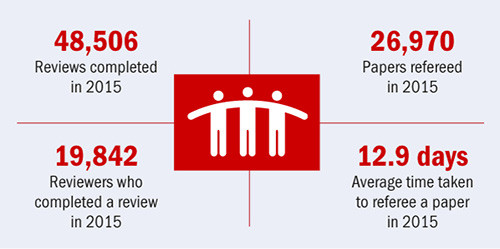By Tushna Commissariat
I mentioned yesterday that it was the start of “Peer Review Week”, which this year takes “recognition for review” as its theme. Physics World is published by IOP Publishing, which makes us a “society publisher” as we’re wholly owned by the Institute of Physics – a charity. IOP Publishing is also a relatively small operation compared with other large commercial publishers, but we still pack a punch, publishing more than 70 journals.
If you’ve ever wondered just how big a deal peer review is to the publishing sector, the infographic above (click on it to see the whole graphic) reveals some key figures such as the number of reviews completed last year at IOP Publishing, the average time taken to complete a review, as well as the reviewers’ geographical spread.
But beyond the figures and numbers, have you ever thought what happens to a paper once it is submitted to a journal? The process can seem like a black box, with a manuscript submitted at one end and a paper published at the other, with no idea of the stages in between.
To answer your questions on what editors actually do and how the whole process plays out, our colleagues from the Journal of Physics series have lifted the lid on the journey an academic paper takes. From the initial submission checks to picking referees to revising a manuscript, the editors tell all in their blog post on “The life of a research paper”.

Guidelines
Show/hide formatting guidelines
this text was deletedwhere people live in harmony with nature and animals</q>
Some text